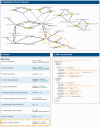An algorithm to detect and communicate the differences in computational models describing biological systems
- PMID: 26490504
- PMCID: PMC4743622
- DOI: 10.1093/bioinformatics/btv484
An algorithm to detect and communicate the differences in computational models describing biological systems
Abstract
Motivation: Repositories support the reuse of models and ensure transparency about results in publications linked to those models. With thousands of models available in repositories, such as the BioModels database or the Physiome Model Repository, a framework to track the differences between models and their versions is essential to compare and combine models. Difference detection not only allows users to study the history of models but also helps in the detection of errors and inconsistencies. Existing repositories lack algorithms to track a model's development over time.
Results: Focusing on SBML and CellML, we present an algorithm to accurately detect and describe differences between coexisting versions of a model with respect to (i) the models' encoding, (ii) the structure of biological networks and (iii) mathematical expressions. This algorithm is implemented in a comprehensive and open source library called BiVeS. BiVeS helps to identify and characterize changes in computational models and thereby contributes to the documentation of a model's history. Our work facilitates the reuse and extension of existing models and supports collaborative modelling. Finally, it contributes to better reproducibility of modelling results and to the challenge of model provenance.
Availability and implementation: The workflow described in this article is implemented in BiVeS. BiVeS is freely available as source code and binary from sems.uni-rostock.de. The web interface BudHat demonstrates the capabilities of BiVeS at budhat.sems.uni-rostock.de.
© The Author 2015. Published by Oxford University Press.
Figures



Similar articles
-
COMODI: an ontology to characterise differences in versions of computational models in biology.J Biomed Semantics. 2016 Jul 11;7(1):46. doi: 10.1186/s13326-016-0080-2. J Biomed Semantics. 2016. PMID: 27401413 Free PMC article.
-
Evolution of computational models in BioModels Database and the Physiome Model Repository.BMC Syst Biol. 2018 Apr 12;12(1):53. doi: 10.1186/s12918-018-0553-2. BMC Syst Biol. 2018. PMID: 29650016 Free PMC article.
-
BioModels Database: a repository of mathematical models of biological processes.Methods Mol Biol. 2013;1021:189-99. doi: 10.1007/978-1-62703-450-0_10. Methods Mol Biol. 2013. PMID: 23715986
-
CellML and associated tools and techniques.Philos Trans A Math Phys Eng Sci. 2008 Sep 13;366(1878):3017-43. doi: 10.1098/rsta.2008.0094. Philos Trans A Math Phys Eng Sci. 2008. PMID: 18579471 Review.
-
Mathematical models in physiology.Philos Trans A Math Phys Eng Sci. 2006 May 15;364(1842):1099-106. doi: 10.1098/rsta.2006.1757. Philos Trans A Math Phys Eng Sci. 2006. PMID: 16608698 Review.
Cited by
-
Identifying frequent patterns in biochemical reaction networks: a workflow.Database (Oxford). 2018 Jan 1;2018:bay051. doi: 10.1093/database/bay051. Database (Oxford). 2018. PMID: 29992320 Free PMC article.
-
Relating simulation studies by provenance-Developing a family of Wnt signaling models.PLoS Comput Biol. 2021 Aug 5;17(8):e1009227. doi: 10.1371/journal.pcbi.1009227. eCollection 2021 Aug. PLoS Comput Biol. 2021. PMID: 34351901 Free PMC article.
-
COMODI: an ontology to characterise differences in versions of computational models in biology.J Biomed Semantics. 2016 Jul 11;7(1):46. doi: 10.1186/s13326-016-0080-2. J Biomed Semantics. 2016. PMID: 27401413 Free PMC article.
-
The Cardiac Electrophysiology Web Lab.Biophys J. 2016 Jan 19;110(2):292-300. doi: 10.1016/j.bpj.2015.12.012. Biophys J. 2016. PMID: 26789753 Free PMC article.
-
SBML Level 3: an extensible format for the exchange and reuse of biological models.Mol Syst Biol. 2020 Aug;16(8):e9110. doi: 10.15252/msb.20199110. Mol Syst Biol. 2020. PMID: 32845085 Free PMC article. Review.
References
-
- Cobena G., et al. (2002) Detecting changes in xml documents. In: Agrawal R., et al. (eds), Proceedings 18th International Conference on Data Engineering, IEEE , San Jose, CA, pp. 41–52.
-
- Cooper J., et al. (2011) High-throughput functional curation of cellular electrophysiology models. Prog. Biophys. Mol. Biol., 107, 11–20. - PubMed
-
- Cuellar A.A., et al. (2003) An overview of CellML 1.1, a biological model description language. Simulation, 79, 740–747.
-
- Davidson S.B., Freire J. (2008) Provenance and scientific workflows: challenges and opportunities. In: Proceedings of the 2008 ACM SIGMOD International Conference on Management of Data, SIGMOD ’08, ACM, New York, pp. 1345–1350, http://doi.acm.org/10.1145/1376616.1376772. - DOI
Publication types
MeSH terms
LinkOut - more resources
Full Text Sources
Other Literature Sources

